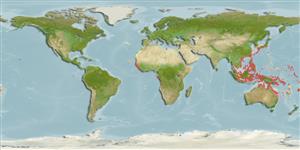Common names from other countries
Environment: milieu / climate zone / depth range / distribution range
Ekologi
; payau. Tropical
Eastern Central Atlantic and Western Pacific.
Length at first maturity / Size / Weight / umur
Maturity: Lm ? range ? - ? cm
Common in estuaries (Ref. 2925). Inhabits muddy sandflats and seagrass areas (Ref. 85382), also on seaweed in bays (Ref. 75835). Part of both epibenthic and arboreal communities in mangrove areas (Ref. 128397). Also found in sandy shores, near the vicinity of the depression formed during low tides to avoid desiccation (Ref. 125338).
Life cycle and mating behavior
Kematangan | Reproduksi, perkembang biakan | Pemijahan | telur-telur | Fecundity | Larva
Members of the order Neritopsina are mostly gonochoric and broadcast spawners. Life cycle: Embryos develop into planktonic trocophore larvae and later into juvenile veligers before becoming fully grown adults.
rujukan utama
Acuan | Koordinator | mitra
Smith, B.D. 2003. (Ref. 3116)
Status IUCN Red List (Ref. 130435)
status CITES (Ref. 108899)
Not Evaluated
Not Evaluated
ancaman kepada manusia
Harmless
penggunaan manusia
| FishSource |
Alat, peralatan
informasi lanjut
Umur / SaizPertumbuhanpanjang-beratpanjang-panjangMorfologiLarvaKelimpahan
Sumber internet
Estimates based on models
Preferred temperature
(Ref.
115969): 25.5 - 29.3, mean 28.6 (based on 1804 cells).
